31/7/2022
FutraHeat is developing a high-temperature heat pump that uses waste heat at around 70°C from industrial processes to generate steam at around 150°C. Heat is a major element of many industrial processes, from pharma to food, and accounts for around 70% of all industrial energy demand. At present vast amounts of this heat is used once, and then wasted. Quite literally, it goes up the chimney or down the drain. Futraheat are targeting products in the 500kW to 1MW range. These will recover waste heat from as low as 70°C, deliver high grade heat up to 150°C and operate with modern low global warming potential refrigerants. They are currently developing a 300kW demonstrator for on-site trials.
Photo FutraHeat
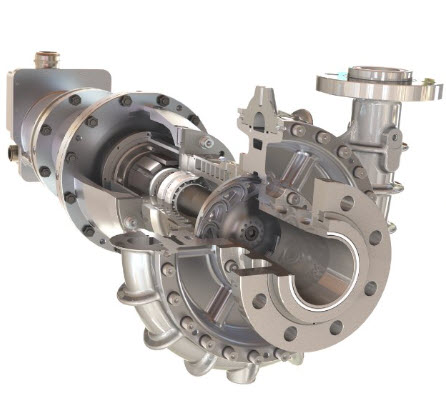
30/7/2022
Researchers from the University of Toronto have come up with a novel way to help sequester Carbon Dioxide. One of the most expensive parts of the Carbon Sequestration process is pumping the air into the machine. The team have come up with a rail mounted system on a train, so as the train travels around the country, the carbon sequestration unit will have the moving air forced into it thus getting all the required air without a pump. All the other CO2 direct air capture systems, compression equipment, and ancillary gear can use the substantial sustainable energy generated on-board the train through regenerative braking as well as from solar panels mounted on compatible railcars. The units could be equipped with large intakes that extend up into the slipstream of the moving train and collect CO2 feedstock air by fluidic, ramjet-type processes thus obviating the need for the fans required by land-based systems and places no demand on energy or land resources. Current technologies to capture CO2 from air employ liquid or solid adsorbents based on amines, oxides, hydroxides, carbons, zeolites, and metal organic frameworks. No matter the material class, however, all require substantial amounts of energy to coax the captured CO2 from the sorbent and to regenerate it for cyclic use. After capture, additional energy is required to collect, compress, and liquefy the carbon dioxide for efficient transportation, geological sequestration, or commercial utilization. This energy is provided by the already moving train.
Photo Joule E Bachman et al https://doi.org/10.1016/j.joule.2022.06.025
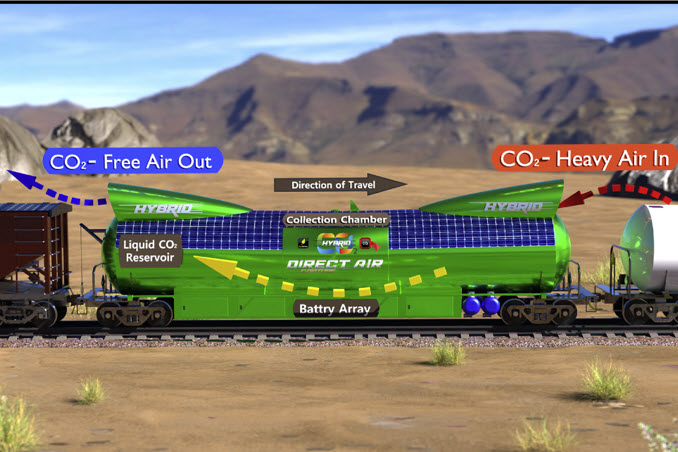
29/7/2022
The latest Met Office report reviews the climate and significant meteorological events of the year. This year’s paper continues to show the impact of global temperature rises on the climate in the UK, reaffirming that climate change is not just a problem for the future and that it is already influencing the conditions we experience on the earth’s surface.
The UK’s climate is continuing to change, recent decades have been warmer, wetter and sunnier than the 20th century.
All of the UK's top 10 warmest years, in the time series from 1884, have occurred this century.
While the year 2021 would be considered near normal compared to the last three decades, before 1990, a year like this would be the second warmest in the series.
In 2021 specifically, UK temperatures and sunshine were near to the 1991 – 2020 average with rainfall slightly below.
Read the full report State of the UK Climate 2021
- published 28 July 2022
Photo Pixabay

28/7/2022
A Spanish scientist José Antonio G. I. claims to have developed a new way to generate and store hydrogen from tap water without using electrolysis. The system is secreet at prresent which suggests that it may not be true. Very few details gave been given out about the process and the chemicals that are used in the process and the costs of running the system. It is probably not true, but it just might be, until we find out more.
Photo Pixabay
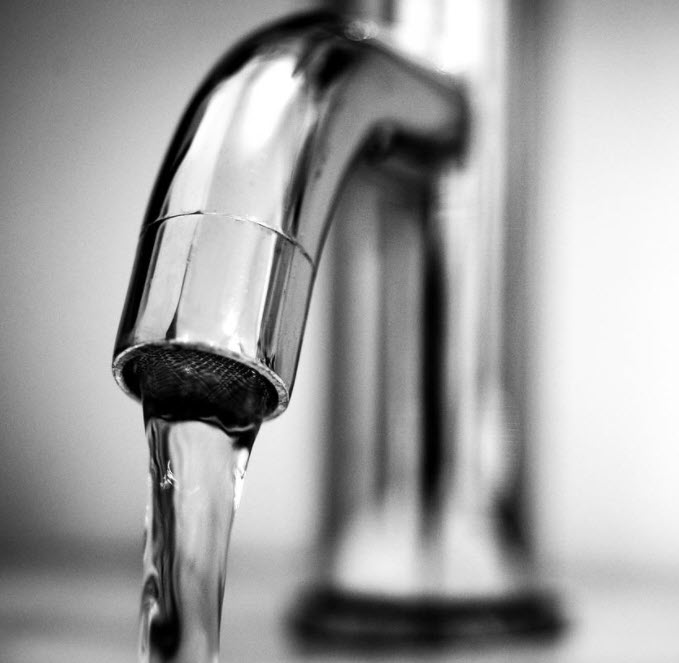
27/7/2022
Many peoples notions about renewable energy is that it is unreliable. We are taught this in schools and, and it would seem this way with solar not working at night and no wind on windless days producing no electricity. But it is not like that. It is true that solar doesn't work in the dark, but with battery systems the power is evened out. The UK has much of its energy offshore and there the wind blows nearly all the time and by spreading out the wind farms, if it is not windy in one place it is in another. The Renewable grid also uses some HEP in Scotland and some wave power which doesn't stop. As more and more renewable energy sources occupy more and more of the grid, the electricity supply is becoming even more reliable than it was under coal and gas.
Photo Pixabay
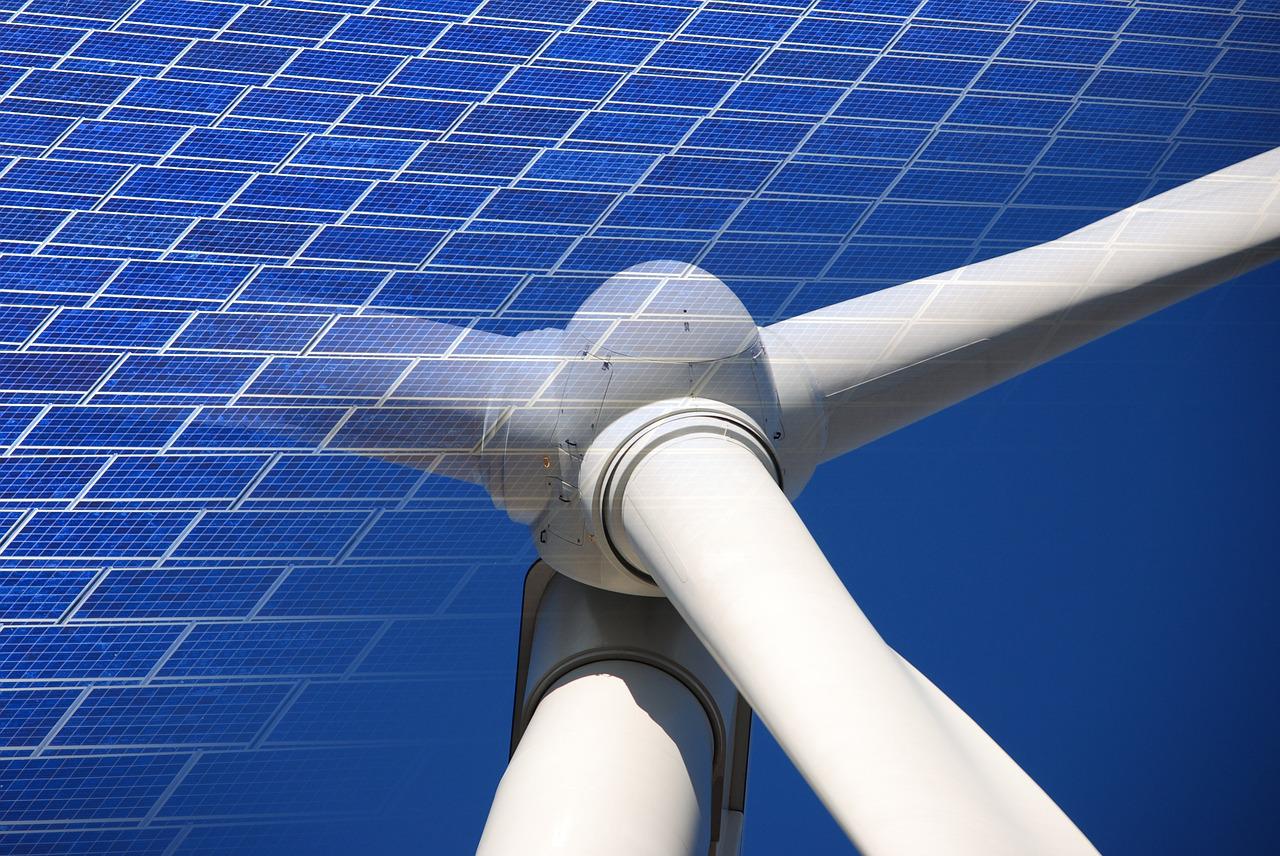
26/7/2022
The EU has asked member states to cut gas consumption by 15% from August, in anticipation of a total shutdown ahead of winter. The German government has asked its citizens and industry to cut back on energy consumption so the country can try to boost its reserves before winter so there is enough gas for the population to heat their homes and cook. If this doesn't happen then rationing would have to be imposed. The German chemical industry relies almost totally on gas. This industry consumes around 135TWh of gas, which is approximately 15% of the country’s total natural gas consumption. Around a quarter of that gas is used as a raw material for the chemical industry. The UK is also worried because they use the German chemicals to supply their industry and without these the UK chemicals industry would face problems. In January 2021 prices were around €20/MWh,. Since then the prices have risen to €150–160/MWh, with further rises expected. This puts knock on price increases on all the chemical produced, both in Germany and the UK and all this must get past on to the consumer. There is a need to switch to renewable energy and technologies like electric crackers, and find new sources of raw materials. This can't happen overnight, but it could make for a better future in years to come.
Photo Pixabay
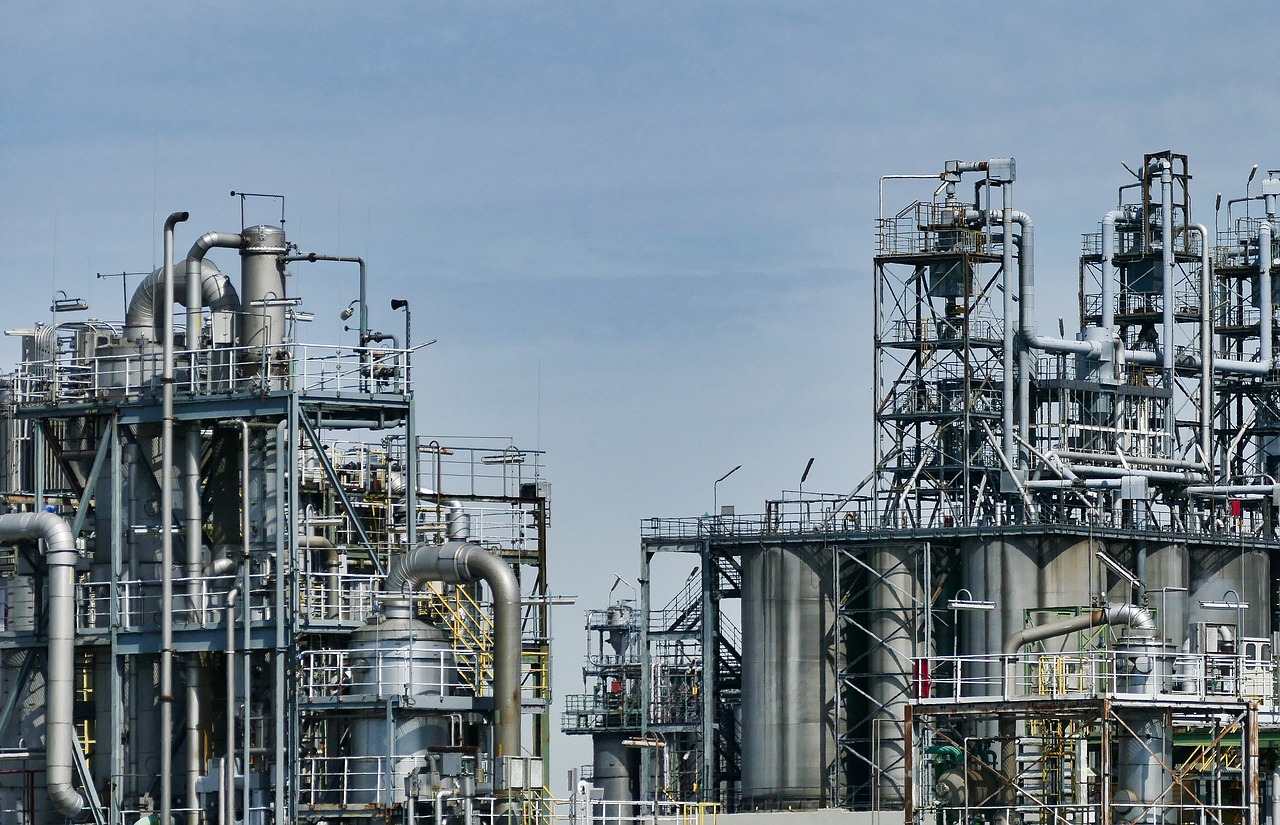
25/7/2022
Researchers from Simon Fraser University are investigating how organisms sense and respond to CO2. The molecular mechanisms by which proteins serve as sensors of CO2 are, of great interest. Because CO2 is electrophilic, one way it can modulate protein biochemistry is by carboxylation of the amine group of lysine residues. However, the resulting CO2-carboxylated lysines spontaneously decompose, giving off CO2, which has made the study of this modification difficult. The Researchers have developed a method to stably mimic CO2-carboxylated lysine residues in proteins. They have developed a quantitative approach to identify CO2-carboxylated lysines of proteins and worked out how the mechanism works.
Image King, Dustin T., Sha Zhu, Darryl B. Hardie, Jesús E. Serrano-Negrón, Zarina Madden, Subramania Kolappan, and David J. Vocadlo. “Chemoproteomic identification of CO2-dependent lysine carboxylation in proteins.” Nature Chemical Biology (2022): 1–10. https://doi.org/10.1038/s41589-022-01043-1.
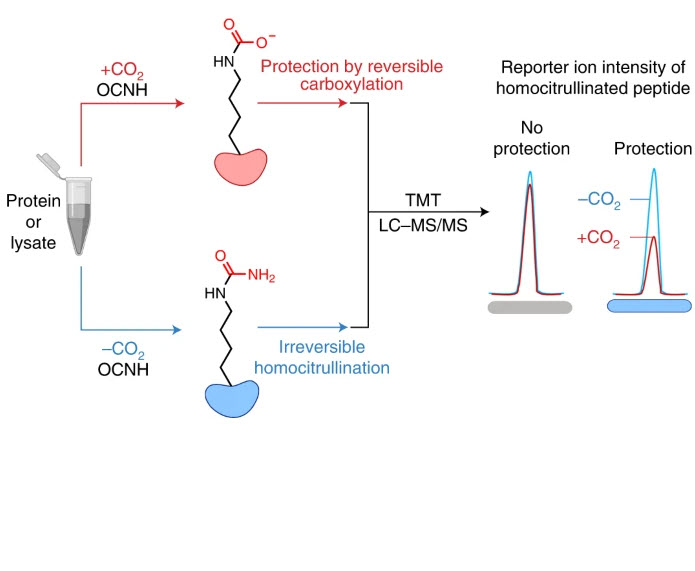
24/7/2022
China has announced a new plan for new-build public buildings and factories in towns and cities to be covered at least 50% with solar panels. This is in part to cut down on the carbon emissions and also increase the amount of electricity that can be generated. China is desperately trying to increase the amount of energy it can produce. The country has increased its production of solar panels to fuel this expansion.
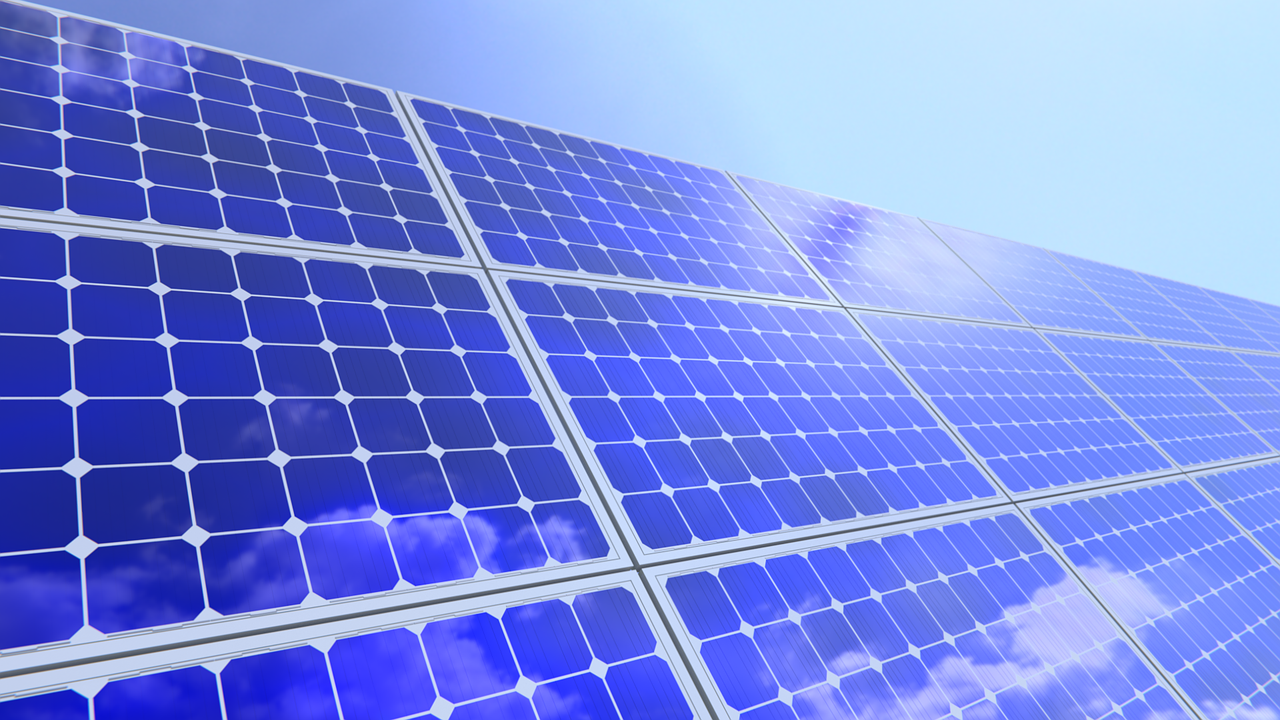
23/7/2022
This has been quite a good July so far for Solar. We have seen a heatwave but even on those days there was still some cloud. The UK does not get days and days of blue skies, But even without those days of wall to wall sunshine, this July is still pretty good and has produced a good amount of sunshine and also solar electricity. We are averaging over 20KWh of electricity per day, even the poor days are quite good.

22/7/2022
Researchers from Helmholtz-Zentrum Hereon have been working on the storage of Hydrogen in Metal Hydrides. For hydrogen to be effectively used as a fuel, not only must it be made in a green way, it must be stored safely. Metal hydrides are a good solution for they can store large quantities of hydrogen in a small space. However, the mining and production of the materials emits a large amount of carbon dioxide. Producing hydrogen storage materials from recycled Magnesium industrial waste could become an effective way of making very pure metal hydrides at a significantly lower cost and with out much Carbon Dioxide production. Metal hydrides can store hydrogen at low pressures and moderate temperatures in a safe and compact way. The metal compounds are first ground into fine powders have a high affinity for hydrogen. Once exposed to hydrogen the metals bond with the single hydrogen atoms resulting in hydride species. This process can easily be reversed by increasing the temperature. In this way the metal hydrides can bind hydrogen in large amounts and release it.
M. Passing et al.; Development and experimental validation of kinetic models for the hydrogenation/dehydrogenation of Mg/Al based metal waste for energy storage; Journal of Magnesium and Alloys; 2022.
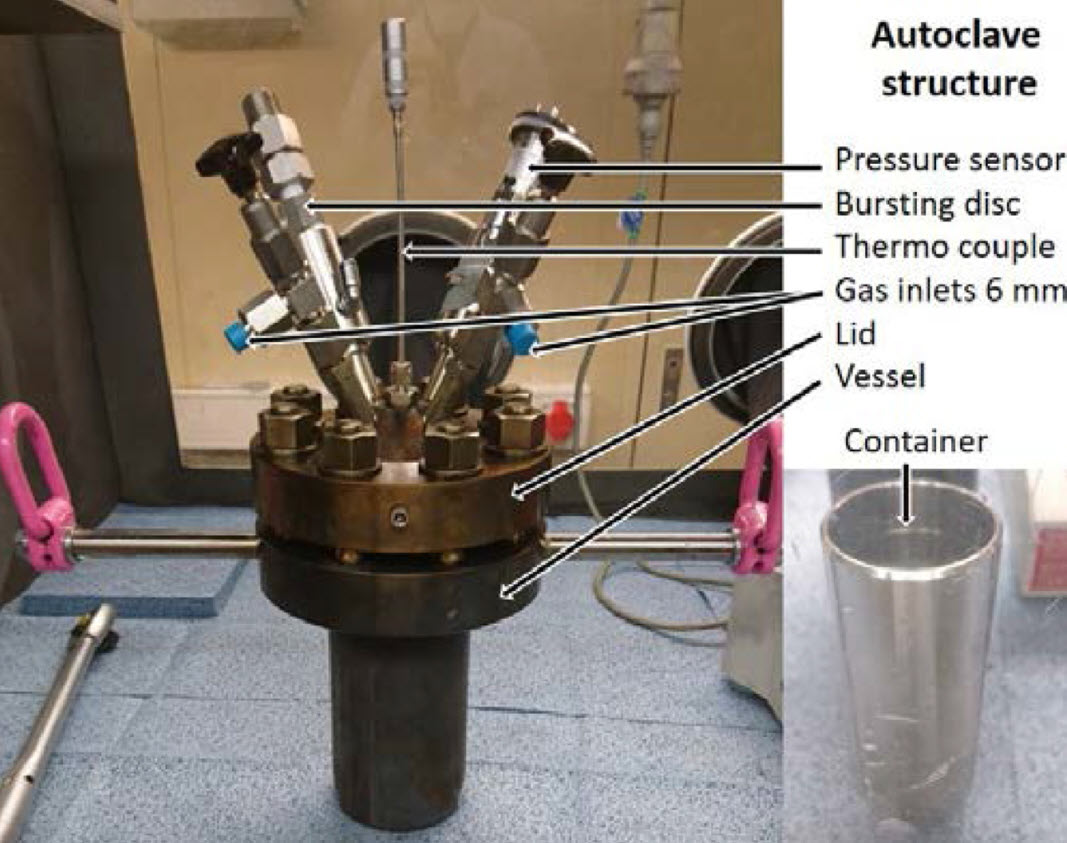
21/7/2022
As a part of the European Union's SUN-to-LIQUID project, Researchers have developed a system that uses solar energy to produce drop-in fuels, which are synthetic alternatives to fossil-derived fuels such as kerosene and diesel. In 2017, the team started scaling up the design and built a solar fuel-production plant at IMDEA Energy Institute in Spain. The plant consists of 169 sun-tracking reflective panels that redirect and concentrate solar radiation into a solar reactor mounted on top of a tower. The concentrated solar energy then drives oxidation-reduction (redox) reaction cycles in the solar reactor, which contains a porous structure made of ceria. The ceria -which is not consumed but can be used over and over -converts water and CO2 injected into the reactor into syngas, a tailored mixture of hydrogen and carbon monoxide. Subsequently, syngas is sent into a gas-to-liquid converter, where it is finally processed into liquid hydrocarbon fuels that include aviation fuel and diesel.
Photo Joule
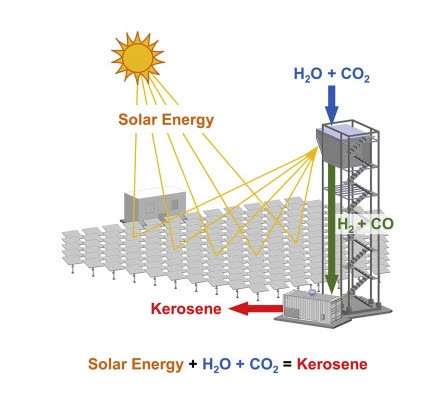
20/7/2022
Yesterday the UK managed a massive 40.3°C in Coningsby, taking the all time record up by massive 1.6°C. In fact quite a lot of the country broke the record and many places managed to cross the 40°C threshold. At these temperatures we are susceptible to wildfires like Europe and other countries. The way we cope and survive in the summer is going to have to change. New infrastructure will now need to be put in to cope with wildfires. New house builds will need to be changed. Old houses will need to be allowed to be modified to cope with the extreme heat as well as the cold. As well as heat we need to be able to cope wit the other changes of the climate, such as better flood defences and higher wind speeds. House regulations will need to be changed as our climate changes.
Photo Pixabay

19/7/2022
Airport runways melted, Areas of the countryside caught fire. Trains ran slowly, some schools shut, where they did work the students struggled to do any work and people frazzled in the heat. This heat is not unusual in many countries, but the UK is not geared up for the heat. The houses are deigned to absorb the heat not loose it. So are we going to have to design new types of houses and modify the houses we live in as we expect these temperatures to re-occur most years and for longer periods. Can we expect to buy double glazed windows that open inwards to that the windows can be opened and then shutters fitted outside that can the locked and secure whilst the windows are opened and in the shade. Should houses in the UK get Air -con although this will use far more electricity?
Photo Pixabay

18/7/2022
It seems that over the last few years we have seen records tumble. I remember the excitement when 38.7C was recorded in Cambridge. Nowhere else was quite as hot and Britain baked in 30C sunshine. But this year it seems that many parts of the country will exceed this value and a greater than 40C record will be set. I have watched with interest old weather forecasts predicting what the weather would be like in 2050 and those show todays forecast, so I wonder what 2050 's weather forecast will be - will we be predicting 45C or maybe even 50C. Climate change isn't coming its here and , carbon neutral by whatever year isn't a necessity, but becoming carbon negative must be.
Image Met office UK

17/7/2022
Mad dogs and Englishmen go out in the midday sun, so the song goes. But that is not going to be sensible for the next few days. Ultra high temperatures - unseen in this country before, means that we Englishmen will not have to follow the song. The best advice seems to be Hydrate well, drink more than normal, seek shade, cool the house as much as possible by allowing good movement of air with windows open and curtains drawn. If you have to go out then try to avoid the midday sun - wear a hat and plenty of sunscreen.

16/7/2022
An urban heat island, is a metropolitan area that's a lot warmer than the rural areas surrounding it. Extra heat is created by all the people, cars, buses, and trains in big cities like Manchester, Birmingham and London. These Urban areas also have very little green space - to cool any part down. On extremely hot days these cities with all their tarmac and concrete and building create much warmer areas than their surrounding rural areas. This temperature difference is more acute in hot conditions adding as much as 5C. At night when the rural areas cool down, the building still give out heat making the cites much warmer at nigh up to 10 degrees and so the cites are warmer early in the mornings and can heat up further for the same amount of solar energy gained. When the UK is forecast temperatures in the high thirties the cites will get much hotter. Although the mean temperature will be high, garden patios and other enclosed areas will be considerably hotter.
Photo Met Office UK
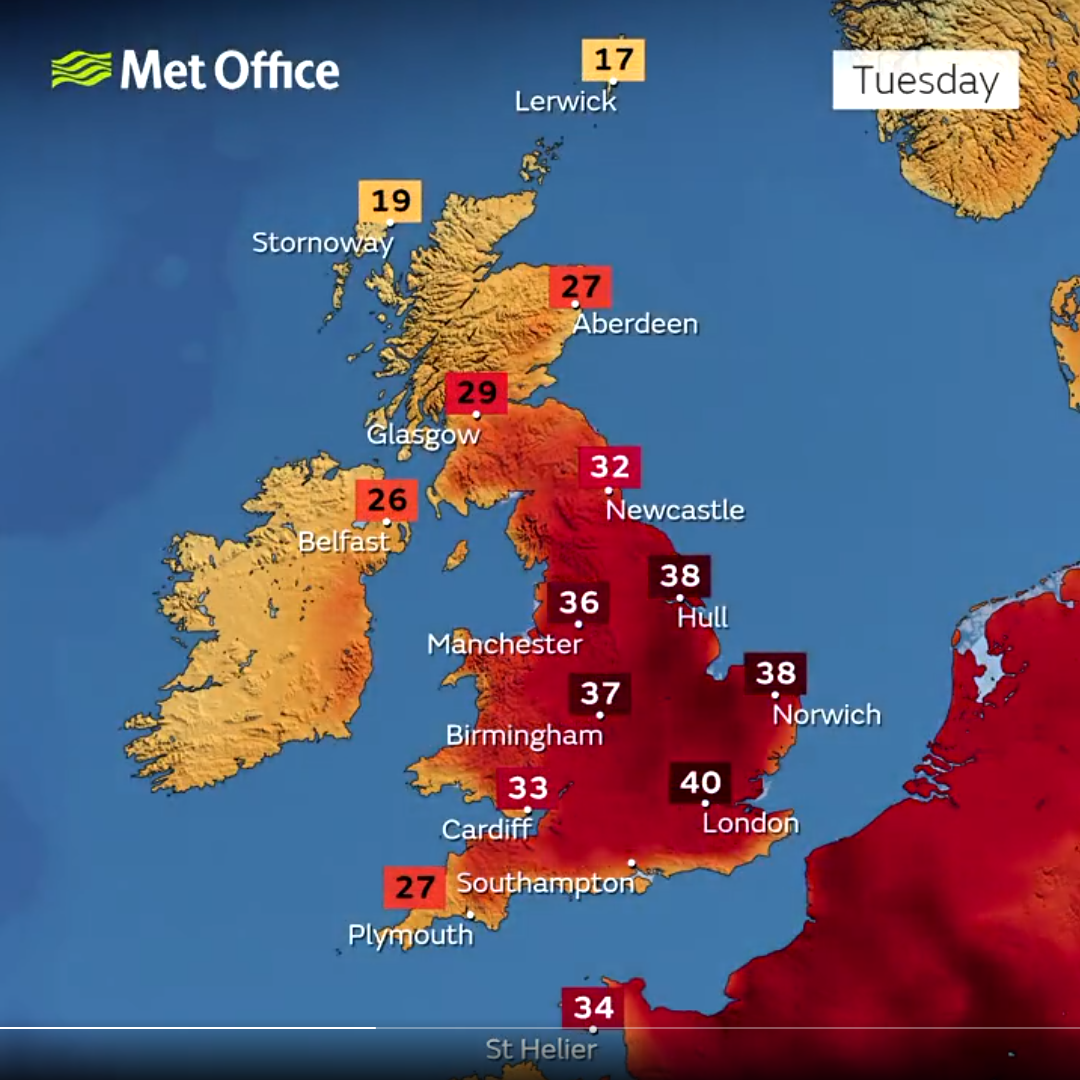
15/7/2022
A local council in Wales, Bridgend County Borough Council, has signed a deal with the Japanese company, Marubeni, to build a 5MW green hydrogen facility in Wales. Green Hydrogen is hydrogen made from the electrolysis of water by electricity made from a renewable energy source such as wind or solar power so the manufacturing plants producing the hydrogen have a very small carbon footprint. Hydrogen used in fuel cells is very efficient and has zero emissions. Hydrogen fuel cells have a higher energy density than both lithium-ion electric batteries and diesel engines, having a one to one ratio of moles of hydrogen to moles of electrons being converted.
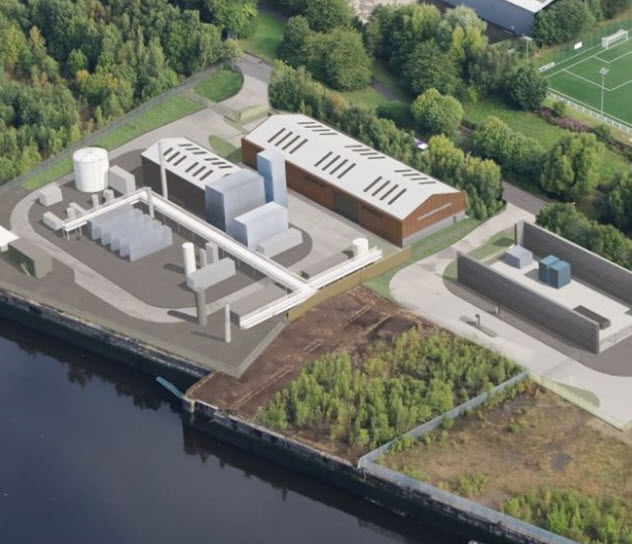
14/7/2022
Utah's Great Salt lake is gradually becoming less Great, as the lake shrinks due to over use of the water. Because of flooding many years ago around the great salt lake, the Government spent millions building a pumping station to remove water from the lake and pumping the water into an adjacent dry basin for evaporation. This started to lower the levels a bit, but then the natural runoff from the mountains reduced and people used more water, and lake levels lowered to safer levels. But, the water kept getting lower. And lower. Once the lake dries up, it’s easy for winds to pick up the dust and carry it into the cities and mountains. Fertilizers, arsenic, and many other things people don’t want in their lungs will all end up in the air. The other problem from a smaller lake is a feedback loop. Without the larger lake to produce lake effect snow, there’s less water in the rivers, and that leads to less water going back into the lake. So, the problem will not only accelerate towards a complete dry-up, but it will leave the people who took too much water from the rivers with less water and less tourism from skiers.

13/7/2022
Fuel cells are not widely commercialized as they could be because they require expensive catalysts. The best catalysts have been a family known as platinum-group metals. While efficient and durable, these metals are expensive and are extremely rare. As a result, scientists are seeking less costly alternatives. One such alternative has been iron-based catalysts. Iron is appealing because it is abundant and inexpensive. But it does not perform as well as platinum, especially because it lacks the durability to withstand the highly corrosive and oxidative environments inside fuel cells. To overcome this barrier, a research team at the University of Buffalo, bonded four nitrogen atoms to the iron. The Researchers then embedded the material in a few layers of graphene with accurate atomic control of local geometric and chemical structures. This is believed to be the most efficient iron-based catalyst produced to date, exceeding the target for electric current density. This could make hydrogen fuel cells, much more affordable for commercial use. The Researchers are planning follow-up studies to further improve the catalyst.
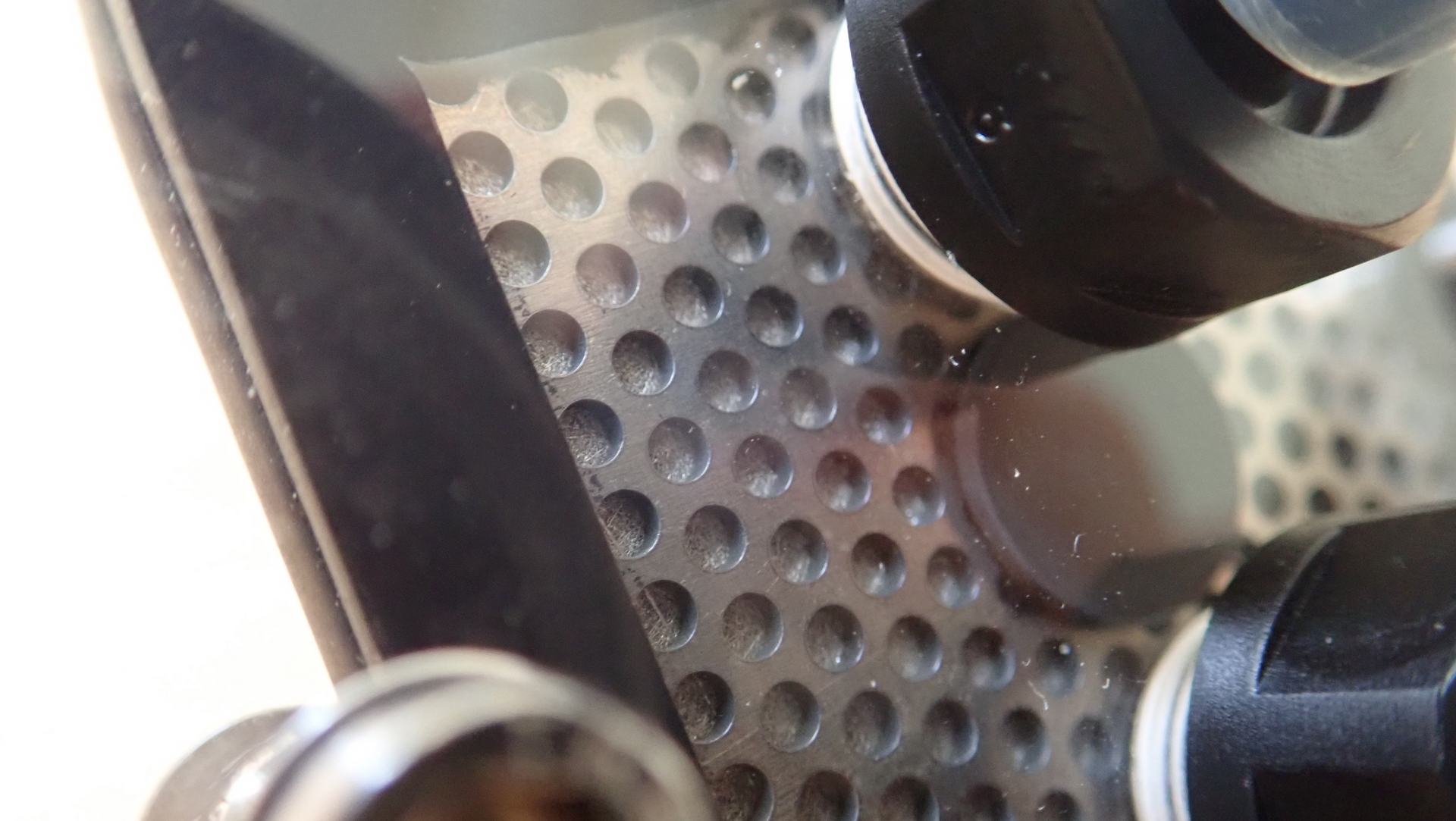
12/7/2022
Sodium is about 100,000x more concentrated in seawater than Lithium. Sodium and Lithium have very similar properties so it is very difficult to just extract Lithium from seawater, but this is just what a team of researchers from Stanford University have done. Using electrolysis the scientists coated the electrodes with lithium lanthanum titanium oxide, and because the lithium ions are smaller than sodium ions , they can easily pass through and into the electrode sandwich. The researchers also changed the electric voltage cycle. First, they applied a negative voltage, and then they briefly turned it off. Next, they applied a positive voltage, turned it off again, and repeated the cycle. The change in voltage causes the lithium and the sodium ions to move into the electrode, stop, and then start to move back out when the current reverses. However, because the electrode material has a slightly higher affinity for lithium than sodium, lithium ions are the first to move into the electrodes and the last to leave. So, repeating this cycle concentrates lithium in the electrode. After 10 such cycles, taking just minutes, there is a one-to-one ratio of lithium to sodium. The cost of electricity for Li extraction with the reported setup is $5 per kilogram

11/7/2022
The most widely used mechanism to capture carbon dioxide from industrial processes is chemical absorption using amine solvents. Once absorbed the carbon dioxide needs to be removed from the solvent and this requires heat, and the amount of energy required can break the economic feasibility of this process. Lots of energy is required for this process and it makes sense that this energy needs to be made renewably otherwise the amount of carbon dioxide produced from the power plant would exceed the amount being sequestered. So we need better ways to sequester the carbon or by using waste heat from other processes to power these reactions. At the moment the cost of sequestration is too high and new mechanisms need to be developed to drive the cost down and make the process of sequestration more economically viable.
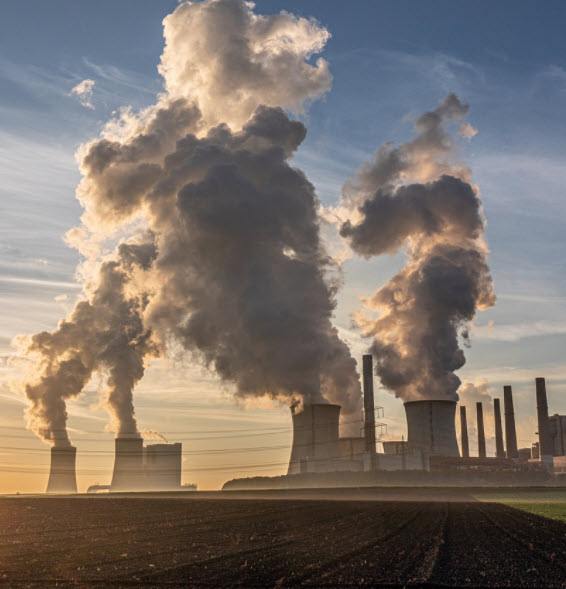
10/7/2022
We have had quite a good start to July with a large amount of sunshine which in turn has generated a fair amount of solar electricity but as the good weather carries on and more days of sunshine are predicted so there is a possibility of hotter weather to come. The indications on some of the models are for even hotter weather next week although this probably won't happen and although the records won't be breached 30C are very likely but the suggestions of 40C are exceedingly unlikely.
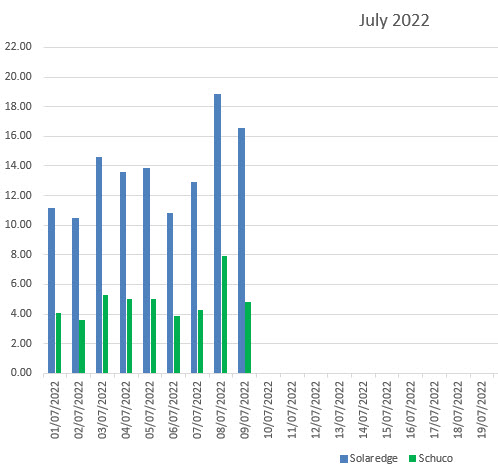
9/7/2022
Scientists from the Leibniz Institute for Baltic Sea Research Warnemünde (IOW)have analysed microplastic pollution in the Northeast Atlantic from a depth of 2000 m water depth with respect to number, size, mass, material and possible origin of the particles. The most common plastic materials were polyethylene and PVC. The Detected microplastics were predominantly small fragmented (<100 μm) particles. The results provide insights into the variability of the sinking microplastics and a first approach to understanding their fate in the ocean.Janika Reineccius & Joanna J. Waniek (2022): First long-term evidence of microplastic pollution in the deep subtropical Northeast Atlantic. Environmental Pollution 305 (2022) 119302
Photo Pixabay

8/7/2022
Researchers at Fraunhofer-Institut für Keramische Technologien und Systeme have joined forces with partners to develop the HyMethShip concept, in which hydrogen is obtained from methanol. This technology does not require large hydrogen tanks to be carried on board, making it much safer. In the future, it may also prove to be an attractive solution for cruise liners. The EU-funded HyMethShip project uses methanol as a liquid hydrogen carrier. In this concept, the ship is refueled with methanol at port. On board, hydrogen is obtained from the methanol through a steam reforming process and is used for ship propulsion. The methanol is mixed with water, then evaporated by applying heat and fed into the preheated reactor, where the mix of methanol and water is converted into hydrogen and CO2. The hydrogen molecules escape through the extremely fine pores of the membrane, while the larger carbon dioxide gas molecules are retained. In this process, the hydrogen achieves a purity level of more than 90 percent. When the ship arrives at port, the CO2 is fed into tanks and can then be used for the next methanol synthesis process.
Photo Pixabay

7/7/2022
Making wine is easy. But making a consistent wine, year after year is much more difficult and is rapidly becoming a real challenge as climate change occurs. As the temperature increases the berries ripen faster building up more sugars and this increases the alcohol content. The acidity decreases as the temperature warms which changes the zest of the wine, pigments like anthocyanins break down in the heat and Tannins important for the taste may not develop if the grapes are harvested early. All these are problems to the vineyards and the industry and changing variety of grape to cope with the climate change, changes the wine.
Photo Pixabay
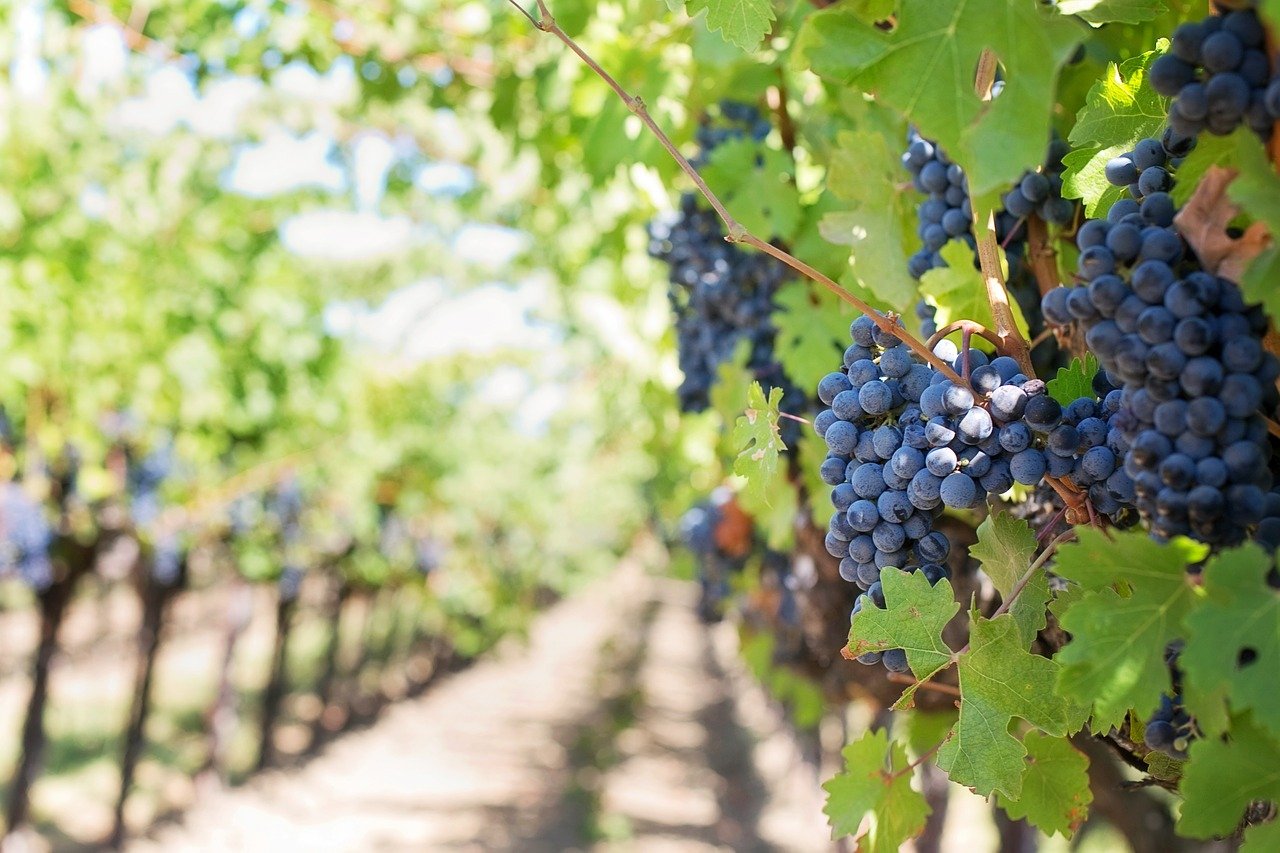
6/7/2022
If it is a Giant Sequoia is can. Henry Emson is running a pioneering project called 'One Life, One Tree', where ordinary people can plant giant sequoias in England and Wales in a protected part of land. Individuals pay for their own sapling and either come and plant it themselves, or Henry and his team will plant it for them. The saplings are not cheap to purchase at £400, but the money generated goes towards purchasing more land to plant sequoias and to pay for forestry and land maintenance. The giant sequoia is a non-invasive species so it doesn’t pose a risk to existing native trees and it is also an endangered one, with all the recent fires destroying many in their last remaining bastion in California. Henry also plants three native trees around every sequoia to prevent monocultures and promote local biodiversity.
Photo Pixabay

5/7/2022
Using glyoxylic acid, researchers at Ecole Polytechnique Fédérale de Lausanne have managed to clip ‘sticky’ groups onto both sides of the plant waste sugar molecules, which then allows them to act as plastic building blocks. By using this simple technique, they were able to convert up to 25% of the weight of agricultural waste, or 95% of purified sugar, into plastic. The inherently degradable nature of these materials means that they can easily be recycled via methanolysis at 64 °C, and then depolymerization in room-temperature water. The properties of these plastics is such that it could allow them to be used in a wide range of applications. The researchers have already made packaging films, and fibres that could be spun into textiles or filaments for 3D-printing.
Image Manker, L.P., Dick, G.R., Demongeot, A. et al. Sustainable polyesters via direct functionalization of lignocellulosic sugars. Nat. Chem. (2022)
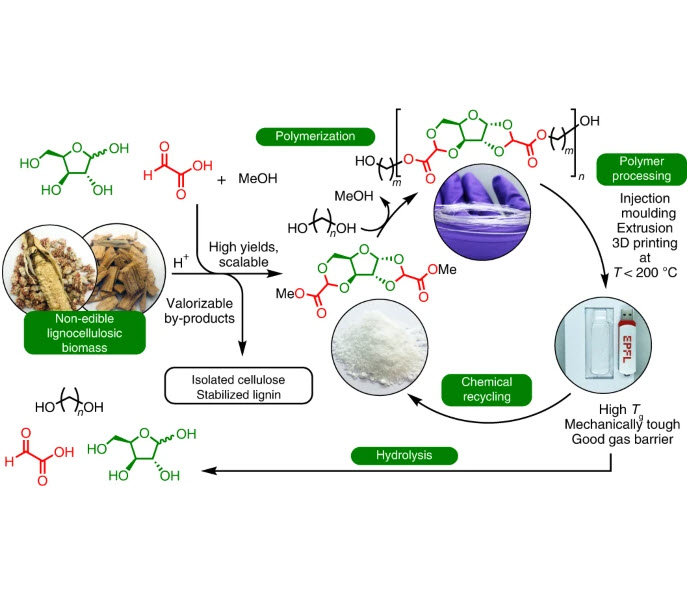
4/7/2022
A group of researchers, led by scientists at the University of Manchester, have developed an economical method of converting methane, into liquid methanol at low temperatures and pressures. The method takes place in a continuous flow of methane/oxygen-saturated water over a novel metal-organic framework (MOF) catalyst using visible light to drive the conversion. The new conversion method could substantially lower the operating costs and with the higher speed of the process and its ability to do the conversion with no undesirable by products makes this system a winner.
Image ORNL/Jill Hemman
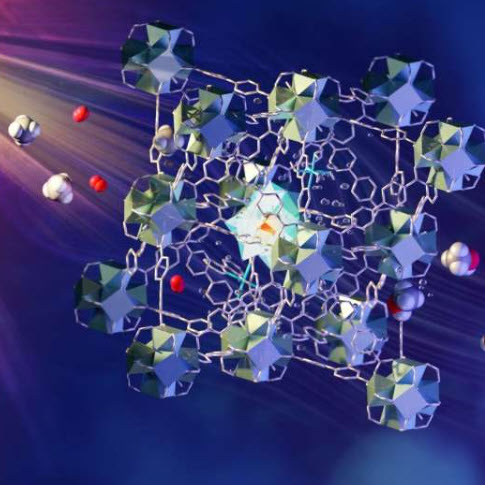
3/7/2022
Researchers at Technische Universität Wien, with the help of a special catalyst material made of sulfur and molybdenum, have managed to make liquid methanol from CO2. In industrial processes where carbon dioxide occurs at a high concentration, for example directly in the exhaust gas stream of large industrial plants, that this catalyst can be used most efficiently. The idea of converting carbon dioxide into valuable products is not new, but most catalysts used so far are poisoned by other chemicals mixed in with the Carbon Dioxide. Special additional elements, such as manganese, ensure that carbon dioxide, which is actually very unreactive, is activated and converted. By choosing such additional elements, the properties of the catalysts can be precisely adapted to the desired area of application.
Photo Technische Universität Wien
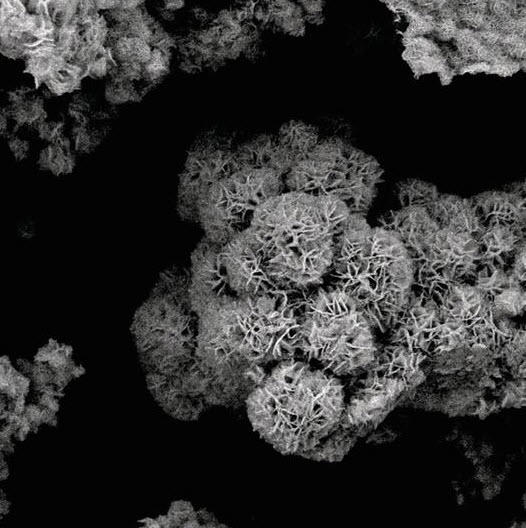
2/7/2022
Researchers at Johann Wolfgang Goethe University, Frankfurt, investigated a species of bacteria that inhabits the deep ocean. To gain the energy it requires, this organism carries an enzyme that catalyzes the rapid conversion of H2 and CO2 into formic acid. Through genetic engineering, the researchers have altered its metabolism to prevent this additional reaction, and even reverse the initial reaction entirely: converting formic acid back into CO2 and hydrogen fuel. These bacteria didn’t require extreme conditions to survive, steadily converting the chemicals at temperatures of just 30° C and at regular atmospheric pressure. Using a bioreactor, the researchers fed their modified bacteria with hydrogen gas for eight hours during the day. This simulated the length of time where hydrogen gas could be realistically produced using the energy harvested by solar panels during the south German summertime. For the remaining 16 hours, they cut off the reactor’s supply of hydrogen, causing any formic acid produced during the day to re-oxidize, and release the hydrogen gas initially consumed by the bacteria. At the same time, the CO2 released from the bioreactor could be re-captured, ready for use in the next storage cycle.
Photo Pixabay
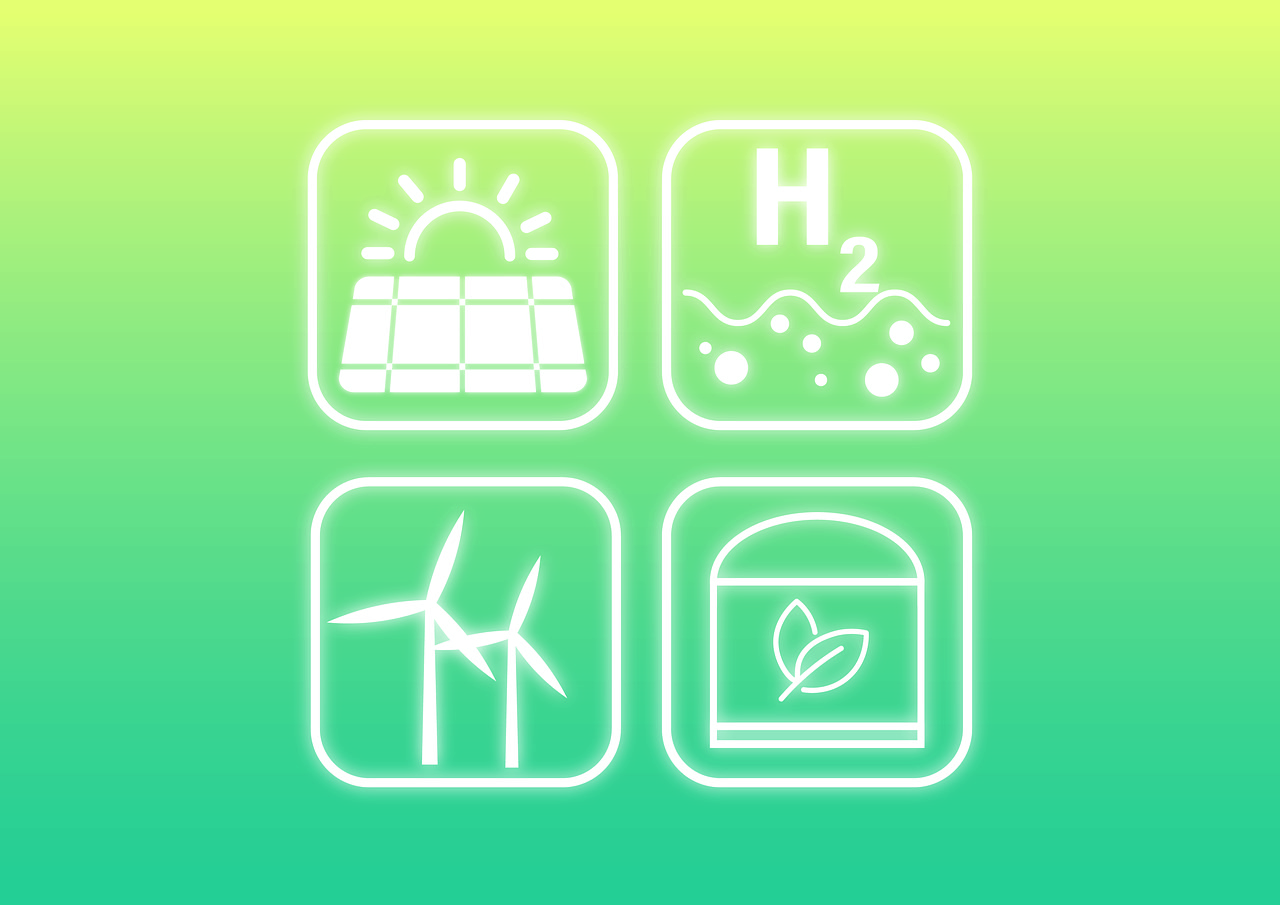
1/7/2022
It seems that across the globe the mouse population is growing. The cause - probably climate change. The winters are becoming less harsh and so the numbers of mice surviving the winter are increasing , givunf rise to increasing populations throughout the year. It is happening in the UK, its happening across Europe and the United States. This is meaning more work for pest control agencies. The mice can cause diseases in the human population but in the UK this is reasonably rare. More research is needed in this ara so perhaps this population growth can be more controlled.
Photo Pixabay

The second best June since our records began 11 years ago. Although not as hot and many really sunny days, we had many days that had a really good amount of sun in between the rain showers. View Data
New ways, New technology